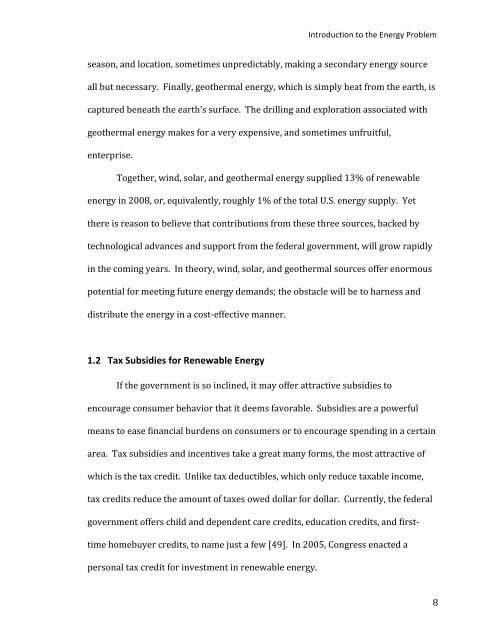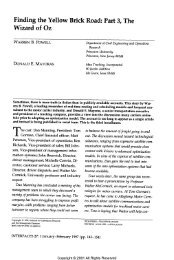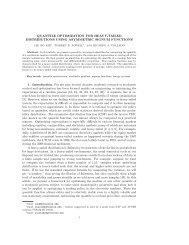Hummer, Merritt-senior thesis final April 2010.pdf - CASTLE Lab ...
Hummer, Merritt-senior thesis final April 2010.pdf - CASTLE Lab ...
Hummer, Merritt-senior thesis final April 2010.pdf - CASTLE Lab ...
Create successful ePaper yourself
Turn your PDF publications into a flip-book with our unique Google optimized e-Paper software.
Introduction to the Energy Problem<br />
season, and location, sometimes unpredictably, making a secondary energy source<br />
all but necessary. Finally, geothermal energy, which is simply heat from the earth, is<br />
captured beneath the earth’s surface. The drilling and exploration associated with<br />
geothermal energy makes for a very expensive, and sometimes unfruitful,<br />
enterprise.<br />
Together, wind, solar, and geothermal energy supplied 13% of renewable<br />
energy in 2008, or, equivalently, roughly 1% of the total U.S. energy supply. Yet<br />
there is reason to believe that contributions from these three sources, backed by<br />
technological advances and support from the federal government, will grow rapidly<br />
in the coming years. In theory, wind, solar, and geothermal sources offer enormous<br />
potential for meeting future energy demands; the obstacle will be to harness and<br />
distribute the energy in a cost-‐effective manner.<br />
1.2 Tax Subsidies for Renewable Energy<br />
If the government is so inclined, it may offer attractive subsidies to<br />
encourage consumer behavior that it deems favorable. Subsidies are a powerful<br />
means to ease financial burdens on consumers or to encourage spending in a certain<br />
area. Tax subsidies and incentives take a great many forms, the most attractive of<br />
which is the tax credit. Unlike tax deductibles, which only reduce taxable income,<br />
tax credits reduce the amount of taxes owed dollar for dollar. Currently, the federal<br />
government offers child and dependent care credits, education credits, and first-‐<br />
time homebuyer credits, to name just a few [49]. In 2005, Congress enacted a<br />
personal tax credit for investment in renewable energy.<br />
8








